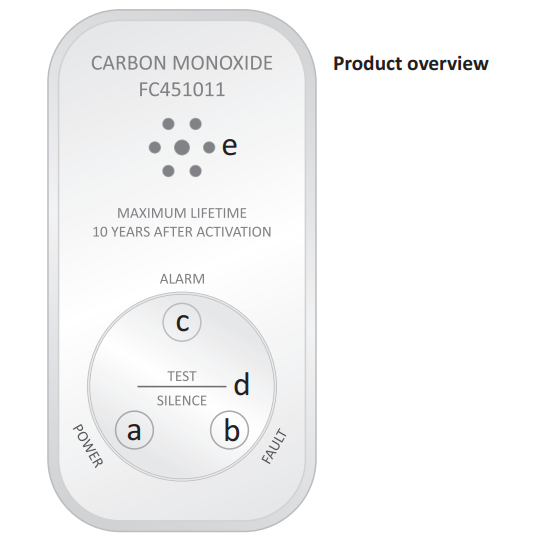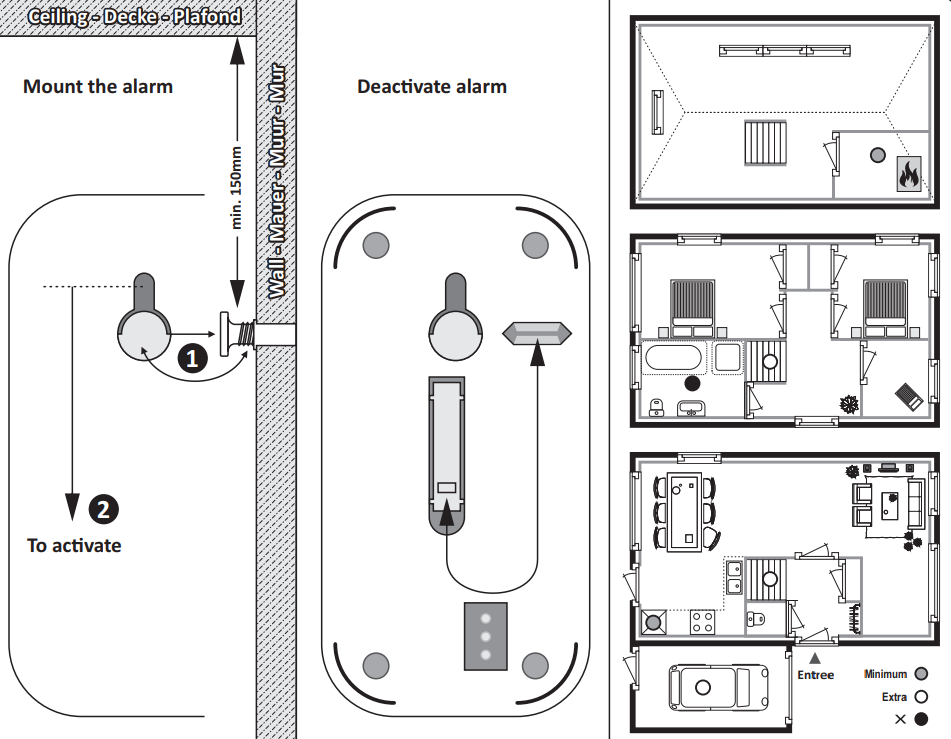ELRO FC451011 Carbon Monoxide Detector Instruction Manual
Home is not a place, it’s a feeling



Congratulations with the purchase of this ELRO carbon monoxide detector! Read these instructions carefully and store them in a safe place for future usage.
WARNINGS
- The installation of a CO-detector should not be used as a substitute for proper installation, use and maintenance of fuel burning appliances including appropriate ventilation and exhaust systems.
- Risk of electric shock or malfunction if the apparatus is tampered with.
- The following substances can affect the sensor and may cause false alarms: methane, propane, isobutene, isopropanol, ethylene, benzene, toluene, ethyl acetate, hydrogen sulfide, sulfur dioxides, alcohol based products, paints, thinner, solvents, adhesives, hair sprays, after shaves, perfumes and some cleaning agents.
- To prevent injury, this apparatus must be securely attached to the floor/wall in accordance with the installation instructions.
- Apparatus should be installed by a competent person.
- Batteries should not be exposed to excessive heat, such as sunshine or fire.
Product overview
a. Power indicator (green)b. Fault indicator (yellow)c. Alarm indicator (red)d. Test/Silence buttone. Alarm sounder
Activate your carbon monoxide detector
The detector contains a sealed battery with a life me of 10 years and will be activated automatically when the alarm is attached to the wall for the first me. After activation, all three LED’s will light up and a beep will sound. The green LED will flash every 3 seconds for 30 seconds to indicate that the device is in the preparation state. A er this, the green LED will flash every 30 seconds to indicate that the device is functioning properly.
Locate your detector
Potential sources of carbon monoxide are: wood-burning stoves, gas boilers and fires, gas hobs, oil and coal burning appliances, portable gas heaters, barbecues etc.
Where to install an detector
- Ideally: in every room containing a fuel-burning appliance and additional apparatuses:
- In every bedroom
- In every room where much me is spent and the alarm sound from other apparatuses may not be heard
- If the number of available apparatuses is limited, then choose for the room where:
- A flueless or open-flued appliance is located
- Where you spend the most time
- In case of bedsit (single room serving as both sitting room and bedroom): locate the apparatus as far as possible from the cooking appliances and near the sleeping area.
- In rooms with a fuel-burning appliance:
- Between 1-3 m distance away from the potential source
- If there is a par on in the room: at the same side of the par on as the potential source
- Always on the wall:
- Close to the ceiling, but at least 150 mm from the ceiling
- Higher than the height of any door/window
- In rooms without a fuel-burning appliance (such as sleeping rooms/hall ways:
- Relatively close to the breathing zones of occupants
Where not to install an detector
- In an enclosed space (in a cupboard/behind a curtain).
- Where it can obstructed (by for example furniture).
- Directly above a sink.
- Next to door/window.
- Next to an extractor fan.
- Next to an air vent / similar ventilation openings.
- In areas where temperature get <-10 / >40 degrees.
- In areas where dirt/dust may block the sensor.
- In a damp/humid location.
- In the immediate vicinity of cooking appliance.
- On a location where light indicator may not be visible anymore.
Mount the detector
- Drill a hole in the wall of 5 mm and insert the plastic plug.
- Insert the screw until it is about 5 mm from the wall.
- Place the unit over the screw.
- Test the alarm by using the test button.
Attention!
The detector will be activated automatically when the alarm is attached to the wall. The detector remains activated even if you remove it from the wall.
Alarm silence mode
Before muting an alarm, always make sure the alarm the alarm is false. In case of doubt, take the necessary action! To mute the alarm, press the test button. The alarm will pause for 5 minutes while the alarm indicator keeps flashing. The alarm will return to alarm mode if the concentration CO is still >45 ppm.
Low battery silence mode
To mute the low batter warning, press the test bu on. The device will enter the silence mode for 9 hours. Make sure to replace the device as soon as possible when you hear the low-battery warning
What to do if carbon monoxide is detected?
If the carbon monoxide detector gives alarm, please take the following actions:
- Keep calm and open all doors and windows. Stop using fuel-burning appliances and turn them off;
- If the alarm continues, evacuate the building. Leave all doors and windows open, and do not enter before the alarm has stopped;
- Get medical help for anyone who is suffering the effects of carbon monoxide poisoning;
- Contact the appropriate maintenance agency. Do not use fuel-burning appliances until they are checked by a competent person.
Maintenance
- Test
- Every month by pressing the test bu on for 0.2 seconds. If the device func ons properly, the red LED-light will flash four times and it will beep simultaneously. If you do not hear a beep or see a light a er the test, the device is not functioning correctly and should be replaced as soon as possible!
- Battery
- If the battery is low running low this the yellow LED will flash 2x every 30 seconds and a beep will sound twice every 30 seconds. This device contains a sealed Lithium-Ion battery that cannot be replaced. When this occurs, please deactivate the device (see paragraph)
- Clean
- Once a month: remove the device from the wall and dust it with a so brush or cloth. After cleaning, always test device by pressing the test button.
Deactivate alarm
WARNING: Deactivation of the alarm is permanent and cannot be undone. To deactivate the alarm:
- Remove the alarm from the screws on the wall
- Remove or break through the label and take out the pin
- Push the pin into the hole
The effects of Carbon Monoxide
Carbon monoxide is colorless, odorless, non-irritating gas which is classified as a chemical asphyxiant, whose toxic ac on is a direct result of the hypoxia produced by a given exposure.
Health effects on healthy adults:
| Concentration | Symptoms |
| 100-200 PPM | 100-200 PPM Slight headache, weakness, potential burden on foetus |
| 200-300 PPM | Severe headache, nausea, impairment in limb movements |
| 300-400 PPM | Severe headache, irritability, confusion, impairment in visual acuity, nausea, muscular weakness, dizziness, weakness |
| 400-500 PPM | Convulsions and unconsciousness |
| 600-700 PPM | Coma, collapse, death |
Specifications
Battery type: Sealed Li um-Ion 3V DC (EVECR17335)Battery life time : 10 yearsType apparatus : Type BSensor: ElectrochemicalAlarm volume : > 85 dB (A) at 1 metersProduct lifetime : 10 years after initial activationOperation Ambient Condition: -10°C ~ +40°C, 30~95% non-condensingStorage/Transport Ambient Condition: -20°C ~ +50°C, 10~95% non-condensing
Symbols
Recycling and disposal: The WEEE symbol (a) means that this product and batteries must be disposed separately from other household waste. When it reaches its end of life, take it to a designated waste collection point in your area to guarantee a safe disposal or recycling. Protect the environment, human health and natural resources! Read the manual (b) before use and store it in a safe place for future use and maintenance.


References
[xyz-ips snippet=”download-snippet”]

